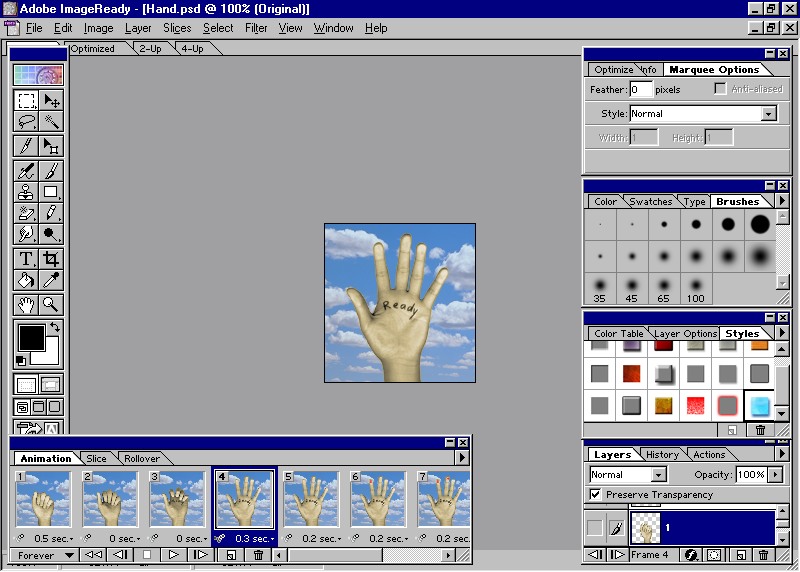
Everything will be taken over to the other program for you. Click “File” and choose “Edit in ImageReady”. Then, erase several random bars on the copy layers – you need one base layer to remain untouched, with all the segments intact:įive: Now we’re ready to animate. On each layer, hit your Layer Styles and apply a gradient overlay set to “Color” mode. Finally, using your single row marquee tool, select and erase a regular number of “spaces” down the length of your bars:įour: We’re almost ready to animate! First, we need some different colors so that our bars “jump”. Then, turn off your background layer by clicking the “eye” icon beside it, and right-click one of your bars and choose “Merge Visible” – this places all of the bars on one single layer.
#Photoshop imageready merge full#
Duplicate the bar, and move each copy into place so that you have a full “graph”. Three: Now we want that bar to go across the canvas. Apply the settings shown below, and you’ll end up with something like this: Finally, hit your layer styles (Layer, Styles) and choose “Gradient Overlay”. Then, rasterize the shape (right-click and choose “Rasterize Layer”). Start out with the rectangle tool, and draw a line up your canvas. Two: First, we’re going to create a stylish “bar” for our graph. If you have a specific purpose in mind for your sound graph, size the canvas accordingly. One: Open a new canvas in Photoshop with a white background, in RGB mode. Any version of Photoshop will work fine for this tutorial – you can even create these in Photoshop Elements, but the steps will change a bit so you’ll need to mess around with settings if you go that route. I’ve seen some music sites that use sound graphs in their headers, and others that use them inside advertising banners – the one thing that remains a constant is that they look cool.Īnimating sound graphs takes just a few steps using Photoshop and ImageReady. So I was checking out a few stereos at the store the other day because mine has gone poof, and when I saw the sound graphs everything clicked into this idea of making them in Photoshop. I have several really great friends who run an online radio station, and several of them also work with graphics constantly. Smart objects are entirely non-destructive, so we can make any changes we need, whenever we need, without having to delete any merged copies, and the changes will instantly appear in the document.Inspiration for writing this tutorial was easy to find.
#Photoshop imageready merge how to#
How to merge layers as a smart objectĪ better way to merge layers is to merge them as a smart object. And, if I decided to make another change at that point, I'd again have to delete my merged layer and redo all of the steps. Once I've made my changes, I would then need to merge the layers again onto another new layer above them, and then reapply my sharpening. And since I've already applied sharpening to the layer, I would lose my sharpening effect. To make any of these changes, I would first need to delete my merged layer. But what if I need to make a change at this point to the effect? Maybe I want to adjust the blur amount, or remove the Black & White adjustment layer, or even change her eye color. Merging the layers onto a new layer made it easy to sharpen the image. The problem with merged layersīut here's the problem we run into. The image after applying Smart Sharpen to the merged layer. I downloaded the original image from Adobe Stock: Here's an effect I'm currently working on in Photoshop. To help us see the benefits of merging layers as smart objects, let's quickly look at the problem with merging them onto a new layer. Let's get started!ĭownload this tutorial as a print-ready PDF! The problem with merging layers onto a new layer I'll be using Photoshop CC but everything is fully compatible with Photoshop CS6.

And, since we're working with smart objects, any filters we apply will be added as smart filters, which means we can sharpen the image or make other changes non-destructively. That way, if we need to make a change, we can simply edit the contents of the smart object, save the change, and then have our changes instantly appear in the document. A better way is to merge our layers as a smart object. Any time we need to make changes to the underlying layers, we need to delete the merged copy, make our changes, and then merge the layers again. By merging layers onto a separate layer, we can apply sharpening or make other changes to the entire image, without the need to flatten the image and throw all of our existing layers away.īut even merging layers onto a new layer still isn't the best way to work.


A popular way to work non-destructively in Photoshop is to merge our existing layers onto a new layer above them.


 0 kommentar(er)
0 kommentar(er)
